The Birkenhead Drill
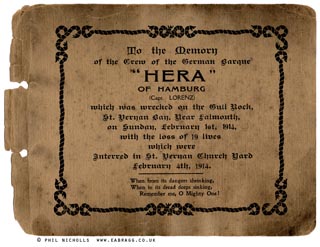
Having spent some time researching our local bit of shoreline that we can see from the Lookout I have come to the conclusion that we have been very fortunate so far as shipwreck is concerned. Obviously there must be a few wartime wrecks a mile or so out but, on our patch, we really only have the Hera. True, some years ago they were towing a broken down ship up channel when she broke partly adrift in a gale.
Unable to hold her they decided that the best option was to beach her in Veryan Bay so they could recover her when conditions were more suitable. Sod’s Law, of course, operated. In allowing her on to the beach she struck the only underwater rocky patch about half a mile out. It is not a big area, not shown on any chart, but big enough to take the bottom out of her. She subsided gratefully on to the sand and there she stayed.
She was so badly damaged that it was decided the only course was to break her up in situ. So, for the best part of twelve months she sat a few hundred yards out while they worked with all sorts of machinery and carted her off to be reduced to something more useful. Some of the equipment used were several huge steel rafts and , when they went, they left these on the beach between Carne and Pendower. Eventually they collected these, probably because everyone was bitterly complaining!
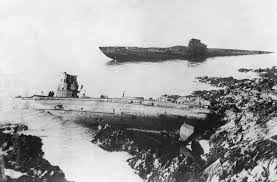 Going beyond Greeb Point towards Falmouth there is nothing of any consequence until you get to near the harbour entrance. There is an old fishing trawler off Maenporth, blown ashore in 1978, and a number of First World War German submarines scattered around between Maenporth and Pendennis.
Going beyond Greeb Point towards Falmouth there is nothing of any consequence until you get to near the harbour entrance. There is an old fishing trawler off Maenporth, blown ashore in 1978, and a number of First World War German submarines scattered around between Maenporth and Pendennis.
There may be anything between five or nine of these and they were all surrendered at Scapa Flow at the war’s end. With the rest of the German Fleet they scuppered themselves in June 1919. Most ships were refloated and the submarines were distributed around the naval ports to be used as gunnery practice targets. A number were anchored out in Falmouth Bay when a storm blew up and they all came adrift. No one is quite sure how many they are but bits of them can still be seen on a very low tide.
Several wrecks occurred actually in Falmouth Harbour and there are a number of wartime ones scattered around but the real ship killer is the Manacles Reef. The name is a derivative of the Cornish words Maen Eglos, Church Rocks, and probably refers to St Keverne Church which is a local landmark, readily visible from the sea – or perhaps to the gravestones which dot the local churchyards marking the last resting place of a thousand seafarers.
Over the centuries it is estimated more than a hundred ships have met their end on this unforgiving reef. On one stormy night in 1809 two big ships were dashed on the rocks, the transport ship Dispatch and the naval brig Primrose. One hundred and ten bodies were washed ashore but many more were never recovered. In 1855 one hundred and ten drowned when the emigrant barque John struck but the most well known is the wreck of the steamship Mohegan on 14th October 1898.
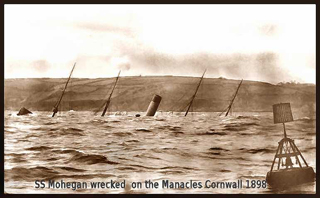 The Mohegan was different. Up till then all of the wrecks had been sailing vessels, unwieldy craft in an unfavourable wind. Sometimes, like the Hera, they had been unable to fix their position accurately because of bad visibility. Sometimes they realised too late that the wind would not allow them to change course and get out of trouble. With no engine to go full astern, no power to turn them away from their fate, the cry, ‘Breakers Ahead’ was all too often their death knell.
The Mohegan was different. Up till then all of the wrecks had been sailing vessels, unwieldy craft in an unfavourable wind. Sometimes, like the Hera, they had been unable to fix their position accurately because of bad visibility. Sometimes they realised too late that the wind would not allow them to change course and get out of trouble. With no engine to go full astern, no power to turn them away from their fate, the cry, ‘Breakers Ahead’ was all too often their death knell.
The Mohegan, however, was a nearly new steamship, and had sailed from London bound for New York, carrying 57 passengers and 97 crew, with a cargo of cattle and the necessary drovers. By the time she was off Plymouth she had worked up her to maximum speed of 13 knots. It was dark and the captain did not realise that a mistake had been made when the last bearing was taken off the Eddystone. Instead of clearing Lizard she was heading straight for the Cornish Coast.
The Coverack Coastguard saw her coming and fired off warning rockets – but it was too late. She struck the Manacles at speed, ripped her bottom out, rolled over and sank within twelve minutes. The Porthoustock lifeboat rescued forty-four but one hundred and seventeen were drowned. The memorial and mass grave can be seen in St Keverne church. The Board of Enquiry verdict was that the wrong course was being steered – but no officers survived so the matter ended there.
When one thinks of shipwreck ones mind turns to perhaps the most famous of all – the loss of the Titanic. Overconfidence in the ship, following common practice at the time holding speed and ignoring ice warning as it was not thought ice could sink a ship, insufficient lifeboats (she only carried enough to accommodate half those on board) – all contributed to the scale of the tragedy. Even the rescue was put under the microscope, particularly the part played by the S.S. Californian, the nearest ship to the Titanic when she struck. The Californian had called the Titanic early in the evening warning of ice and she herself had stopped to wait until daylight. The Titanic ignored the warning. The Californian should have been near enough to see the Titanic’s distress signals but she didn’t and was one of the last ships to take part in the rescue.
One always hears of the term, ‘Women and Children First’ in connection with shipwreck. Where did the phrase come from? It is popularly attributed to the loss of the troopship ‘Birkenhead’ in 1852. The Birkenhead was an iron-hulled ship originally intended for the Royal Navy but later re-designed as a troopship. She was a paddle wheeler.
In 1852 she was on a voyage to South Africa carrying some 680 persons, men women and children, troops and their families from ten different regiments. Off Danger Point near the tip of South Africa she struck an uncharted rock not far from the shore. An attempt was made to anchor her but, before this could be done, she struck a second time, severe underwater damage being done – she was fatally injured. The sea rushed in and it is thought about 100 soldiers died in their bunks.
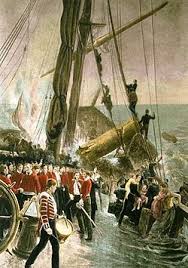 The ship’s captain was Captain Salmond but the senior soldier on board was Lt. Col. Seton. He mustered the officers and men on the deck impressing on the officers the need to maintain discipline to avoid a panic. They began to launch lifeboats but the first was swamped and the next two could not be moved as the falls, the ropes that hoist them, had been painted over. Three boats were launched with the women and children inside them.
The ship’s captain was Captain Salmond but the senior soldier on board was Lt. Col. Seton. He mustered the officers and men on the deck impressing on the officers the need to maintain discipline to avoid a panic. They began to launch lifeboats but the first was swamped and the next two could not be moved as the falls, the ropes that hoist them, had been painted over. Three boats were launched with the women and children inside them.
Fortunately it was a calm night and they stayed close to the ship. When it became obvious that the ship was sinking Captain Salmond called out,’All who can swim jump overboard and make for the boats.’ Lt. Col. Seton, however, recognizing that the ensuing rush could swamp the boats, order his troops to stand fast. The ship sank from under them and they did the best they could trying to swim the two miles to the shore. Sharks, exhaustion, hypothermia and inability to swim accounted for the four hundred and fifty odd casualties.
The sinking of the Birkenhead is possibly the first occasion when the concept of ‘women and children first’ was applied. This may or may not be true but the incident is well recorded in a painting by Thomas Hemy ‘The Wreck of the Birkenhead’ and by that great recorder of heroic incidents, Rudyard Kipling: – ‘So they stood an’ was still to the Birken’ead drill, soldier an’ sailor too’!
The biggest British Registered ship ever lost at sea was the M/V Derbyshire, a giant ore carrier that could carry 160,000 tons of cargo. She was 1000 feet long and 150 ft wide. You may have all seen the pictures on television of the new aircraft carrier Queen Elizabeth. The Derbyshire was a bigger ship yet she vanished off Japan in 1980, without any distress call, all 42 of her crew going with her.
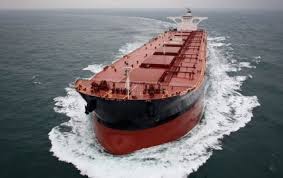 A ship of this size just disappeared! What happened? To start with they had no idea as to the exact location of the wreck and underwater search equipment of that time would not operate at the depths involved. Development continued and in 1994 a further search by David Mearns found the wreck and underwater photography established what had happened.
A ship of this size just disappeared! What happened? To start with they had no idea as to the exact location of the wreck and underwater search equipment of that time would not operate at the depths involved. Development continued and in 1994 a further search by David Mearns found the wreck and underwater photography established what had happened.
Right at the furthest point of the ship’s bow is a large compartment used as a bosun’s store. There are ventilators above this allowing air into the compartment so a man can work in there if necessary. Photographs showed that these ventilators had been severely damaged, allowing water coming over the bow to fill the foremost compartment of the ship. The weight of water dragged the bow down, allowing the sea to break completely over the bow and land on the forward cargo hatch.
This broke the hatch allowing water into the cargo compartment. The extra weight dragged the bow lower, the sea then ripped out the next cargo hatch. There were nine hatches and, as the ship’s bow went lower in the water, these hatches were all ripped off, just like you undoing a zip fastener. The ship became almost vertical and the accommodation block was ripped away. It is estimated that the time between the first cargo hatch going and the vessel starting to sink was about two minutes.
In these modern times, with the establishment of GMDSS in 1979 it was decided that it was no longer necessary to carry a dedicated Radio Officer. In theory in order to send a distress call you only have to push a red button. For some reason no one on Derbyshire appears to have done so. Perhaps only two or three people on the bridge caught out by the tilting deck? We will never know. Forty two crew and two wives were lost – there were no survivors.
We of the N.C.I. at Portscatho do not have to concern ourselves with big ship matters. Our work is aimed at leisure craft and small fishing boats, anyone on the water within visual distance. Last July our ‘buddy station’ St Agnes was instrumental in the rescue of a kayaker off Trevaunance Cove. Maybe they saved his life. I won’t go into it here but you can read about it in the Roseland Magazine or the St Agnes Lifeboat website. The work we do can save lives and we still need volunteers. Ring Sue: 01872 530500, or Chris: 01326 270681.
Pictures courtesy of Wikepedia & Phil Nicholls

